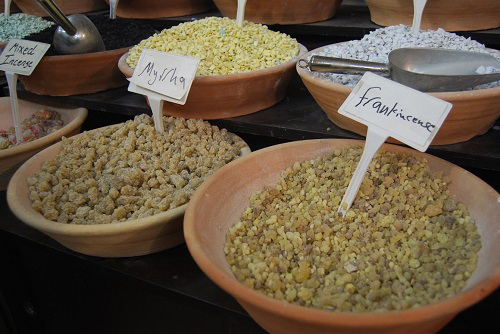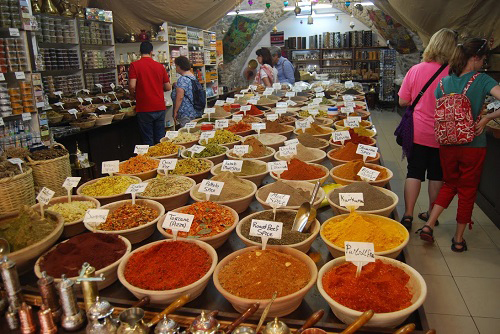by Barry Britnell
Synopsis: Sometimes you learn things about the Bible when you are not expecting it. This time, I learned something while walking around a spice shop in the Old City of Jerusalem.
In Matthew 2:10-11, we read:
When they [the wise men] saw the star, they rejoiced with exceeding great joy. And when they were come into the house, they saw the young child with Mary his mother, and fell down, and worshipped him: and when they had opened their treasures, they presented unto him gifts; gold, and frankincense, and myrrh (Matt. 2:10–11, KJV)
I know that for many years, I read that passage, and it never occurred to me to consider those three gifts. Most of us understand what gold is. We all probably have pieces of jewelry or family heirlooms that consist of entirely (or partially) of gold. However, what about frankincense and myrrh? Do we have either of those items lying around the house? What exactly are frankincense and myrrh?
Earlier this year, I was leading my tour group through the Old City of Jerusalem. Within the Old City, there are at least five or six spice shops. The vibrant colors and fragrances are always enough to catch my attention and draw me in. This time, a couple of bowls caught my eye. Sitting next to each other, there they sat: a bowl of frankincense and a bowl of myrrh. I was thrilled to see it, and in doing so, it prompted me to learn about these two items.
Frankincense is a resin from different types of frankincense trees. It is harvested by stripping the bark off the tree and then collecting the hardened resin as it emerges from inside the tree. In ancient times, frankincense is mostly used as an incense and in perfumes. In the Old Testament, frankincense is mentioned several times in connection with preparing a meat sacrifice for the Lord. Consider the following command from Leviticus:
When anyone brings a grain offering as an offering to the Lord, his offering shall be of fine flour. He shall pour oil on it and put frankincense on it and bring it to Aaron's sons the priests. And he shall take from it a handful of the fine flour and oil, with all of its frankincense, and the priest shall burn this as its memorial portion on the altar, a food offering with a pleasing aroma to the Lord. But the rest of the grain offering shall be for Aaron and his sons; it is a most holy part of the Lord's food offerings (Lev. 2:1–3, ESV).
Similarly, myrrh is extracted from small trees and can be used as an incense and in perfume. However, myrrh can also be ingested if mixed with certain liquids. In certain situations, this mixture can have an intoxicating effect. While Jesus was hanging on the cross, He was offered wine mixed with myrrh (Mark 15:23). After He had died, we read that myrrh was used in the process of burying the body of Jesus:
After these things Joseph of Arimathea, who was a disciple of Jesus, but secretly for fear of the Jews, asked Pilate that he might take away the body of Jesus, and Pilate gave him permission. So he came and took away his body. Nicodemus also, who earlier had come to Jesus by night, came bringing a mixture of myrrh and aloes, about seventy-five pounds in weight. So they took the body of Jesus and bound it in linen cloths with the spices, as is the burial custom of the Jews (John 19:38–40, ESV)
Seeing these two items in the spice shop reminds me of several wonderful facts: The Bible is real. The people are real. Even the smallest of details, like frankincense and myrrh, are real. Knowing this, I can have confidence in the wonderful message contained therein.
I wonder what I will see the next time I am in Israel?
Author Bio: Barry Britnell is the founder of Exploring Bible Lands, LLC (exploringbiblelands.com) and leads Bible Study tours to the land of Israel. He also works with Appian Media (appianmedia.org) to produce biblically-sound videos used in teaching others about the Bible. Barry and his wife, Tabatha, have three children and live in Athens, AL, and worship with the Capshaw church of Christ. He can be reached at barry.britnell@exploringbiblelands.com.

